
オパールの価値:オパールの等級分けと各種類の価格
 オパールは他の宝石とは多くの点で異なり、その評価方法にも違いがあります。オパールにはそれぞれ独自の評価基準がありますが、オパールの種類によって、他の種類よりも高い評価を受ける理由が異なります。
オパールは他の宝石とは多くの点で異なり、その評価方法にも違いがあります。オパールにはそれぞれ独自の評価基準がありますが、オパールの種類によって、他の種類よりも高い評価を受ける理由が異なります。
とはいえ、オパールは価値判断が最も難しい宝石の一つと言えるでしょう。その理由は、オパールの鑑定士がオパールの種類、産地、色、輝きなど、様々な要素を考慮しなければならないため、価格のばらつきが激しいからです。
オパールは高価な石ですか?確かに高価な石ではありますが、種類や品質によって価格は大きく異なります。ご興味があれば、史上最高額で取引されたオパールは、1949年にジョン・D・ロックフェラーが7万5000ポンドで購入した「ファイアー(またはフレイム)クイーン・オパール」です。これは現在の価値で約362万700ドルに相当します。もう一つの高価なオパールは、ヴァージン・レインボーです。これは巨大な天然の暗闇で光るオパールで、現在100万ドル以上の価値があります。
オパールの価値はどうやってわかるのでしょうか?オパールの価値を知るための第一歩は、オパールの等級付け方法と注目すべき特性を知ることです。
このガイドでは、オパールの各価値要因、知っておくべきグレーディング用語、オパールの種類、予想される価格などについて詳しく説明します。

オパールの等級付け方法:11の価値要因
オパールの価値は、透明度や色などの標準的な宝石の等級から、遊色効果や模様などのオパール特有の等級まで、さまざまな要素によって決まります。
オパールの1カラットあたりの価値はいくらでしょうか?それはオパールの品質と、以下で説明する要素によって異なります。
残念ながら、ダイヤモンドのような宝石のように、オパールの価値を正確に算出できる総合的なオパール価値計算ツールは存在しません。専門家は、様々な価値要因を考慮して、特定のオパールの価値を判断する必要があります。
Opal Smart Chartソフトウェアパッケージのような便利な製品もありますが、約145ドルと高額なので、誰でも利用できるわけではありません。そこで、オパールの価値を判断するためのガイドを作成しました。
ここで説明するオパールの価値を決める 11 の要素は次のとおりです。
オパールの種類
カラー(ボディトーン)
遊色指向性
遊色模様
輝度
明瞭さ
透明性
形を整えたりカットしたり
原産国
天然 vs. 合成 vs. 模造品
治療
専門家がオパールの等級付けを行う際は、一定の条件下で行うことが多く、白熱灯や日光の下で石を観察することがよくあります。オパールを購入する際には、様々な照明の下で、あらゆる角度から宝石を観察することが重要です。
オパールの価値を評価する最初のステップは、見ているオパールの種類を特定することです。
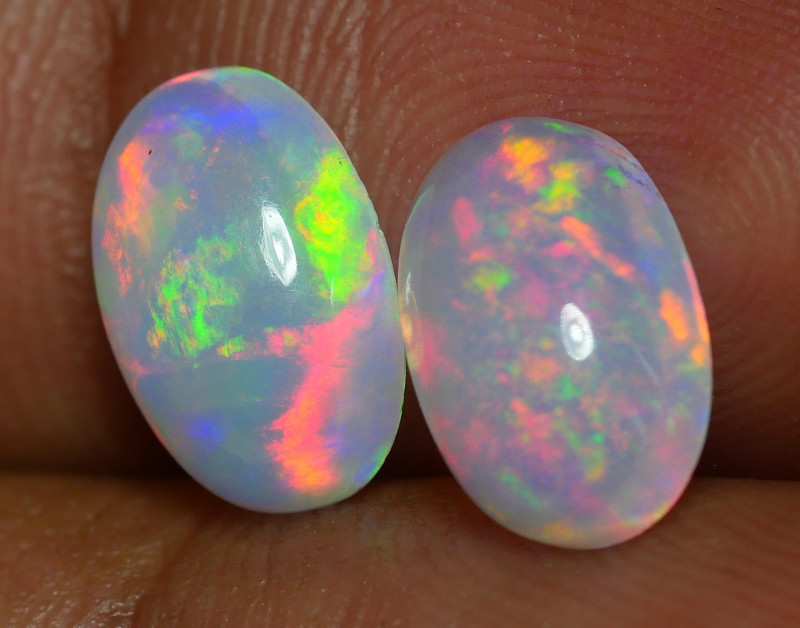 上の写真:貴重なオパール
上の写真:貴重なオパール
1. オパールの種類
オパールの中には、他のオパールよりも希少であるために、単純に価値が高いものもあります。
オパールには多くのカテゴリとサブカテゴリがありますが、すべてのタイプのオパールは、 プレシャスオパールとコモンオパールの2 つの包括的なグループのいずれかに分類されます。
プレシャスオパールは遊色効果を示しますが、コモンオパールは遊色効果を示しません。(注:遊色効果は、カラープレイ、フラッシュ、ファイアとも呼ばれます。)この違いは単純ですが、オパールの価値に大きな影響を与えます。全体的に見て、プレシャスオパールはコモンオパールよりもほぼ常に高い価値を持っています。
反射する光の色の強さも価値に影響を与えます。主に赤やオレンジの光を放つものは、紫や青の光を放つものよりも希少で、価値が高くなります。
貴石と普通石の区別以外にも、オパールの等級分けは、起源、内包物、集合体(ダブレット、トリプレット、モザイク)、形成(天然と合成)、および石体の色調などの要素によっても行われます。

2. 色(ボディートーン)
一般的に、オパールの価値を決める最も重要な要素は色です。オパールの色を評価するには、ベースカラー、つまり背景色であるボディトーンに注目します。そのため、「ボディトーン」は「背景色」または「ベーストーン」と呼ばれることもあります。
ボディトーンは遊色効果や明るさとは別の要素ですが、両方に影響を与える可能性があります。ボディトーンが暗いほど、遊色効果は明るいボディトーンよりも明るく見えるため、暗い色のプレシャスオパールは明るい色のものよりも価値が高くなります。
幸いなことに、オーストラリア オパール協会は、分類を容易にするための便利なボディトーン ガイドを作成しました。
トーンはN1からN7、またはN9までで、グレーディングを行う人によって異なります。N1からN4は常に最も暗いボディトーンを表します。N5からN7はグレーオパールを表す場合もありますが、N1~N9チャートを使用する人は、N5とN6をダークオパール、N7からN9をライト/ホワイトオパールと表現します。
このグレーディング分類は、オパールの3つの基本的な種類、つまりブラック、ダーク/グレー、ライト/ホワイトに基づいています。もちろん、他の色のオパールは考慮されていません。他の色は通常、その希少性によって決まります。暖色系の色は希少で、緑や青はより一般的です。紫やバイオレットは希少ですが、赤やオレンジほど価値はありません。
さらに、オパールのボディトーンの色調と彩度も価値に影響を与えます。より純粋で明るい彩度を持つ色合いは、より明るい、鈍い、または不純な色合い(つまり、アンダートーンのある色)よりも高く評価されます。
上記にオパールボディトーンチャートが示されています。

3. 遊色効果:方向性
遊色効果はオパールの価値を高める要素ですが、多くのオパールはこの炎のような輝きを放ちます。遊色効果の特定の側面、例えば方向性によって、一部の貴重なオパールは他のオパールよりも価値が高くなります。
方向性とは、オパールの遊色効果の輝きが特定の角度からのみ見えることを指します。方向性のないプレシャスオパール(「フルフェイス」と呼ばれることもあります)は、どの角度から見ても同じ輝きを見せます。このようなオパールは非常に貴重ですが、希少です。
その他の方向性の程度は、次のように分類されることが多いです。
わずかに方向性がある:角度によって明るさがわずかに変化しますが、明るさのレベルは 1 つ以上変化しません (明るさのレベルについては後ほど説明します)
ある程度方向性がある: 明るさが特定の方向に少なくとも 1 レベル変化します
非常に方向性がある:特定の方向では明るさがほとんど失われます
指向性が高い:特定の方向では明るさが完全に失われ、多くの場合、一方向だけが明るくなります。
ほとんどのオパールはある程度の方向性を示しますが、方向性が低いほど価値が高くなります。正面から見ると輝きが失われる場合、横から見ると輝きが失われる場合よりも価値に悪影響を与える可能性があります。
オパールジュエリーの種類も、理想的な方向性を決める要因となります。真下から見上げたときに最も輝くオパールは指輪として、垂直に見上げたときに最も輝くオパールはペンダントとして最適です。
色彩遊びのもう一つの側面は、オパールに現れる模様です。

4. 遊色効果:パターン
パターンとは、オパールの遊色効果の形や配列を指します。オパールパターンガイドでは、数十種類のパターンをご覧いただき、詳しく学ぶことができます。
パターンは遊色効果の分布も考慮します。遊色効果が局所的に現れるよりも、均一に広がる色の分布の方が優れています。消光、つまり遊色効果が全く見られない「デッドスポット」のあるパターンは、あまり価値がありません。
パターンの好ましさは主に好みによりますが、最も希少かつ最も価値のあるものとして際立っているのが、 ハーレクイン パターンです。
ハーレクイン・オパールは、縮尺が合う正方形またはダイヤモンドの繰り返し模様が特徴です。最も希少な種類は、オーストラリアのライトニングリッジ産の非常に濃い色のオパールに赤いハーレクイン模様が見られ、1カラットあたり5,000ドルから30,000ドルの値が付くこともあります。
その他の希少で貴重なパターンは次のとおりです。
サンバースト/スターバースト
石畳
指紋
ネオンフラッシュ
サバ
大聖堂
中国語の書き方
ローリングファイア
風車
一般的に、フラッグストーンのような幅広く大きなパターンは、ピンファイアのような小さく密集したパターンよりも価値があります。
模様に関係なく、より明るい色彩の遊びがオパールの価値を左右します。

5. 明るさ
オパールの価値を決める要素として、地色に次いで最も重要なのは、おそらく輝きでしょう。場合によっては、輝きが地色よりも重要になることもあります。
色の変化が数色しかない明るいオパールは、多くの色の輝きがある鈍いオパールよりも価値が高い場合が多いです。
明るさは、模様や方向性といった要素よりもはるかに分かりやすいものです。ボディの色調と同様に、明るさの等級はオーストラリアオパール協会が作成した便利なチャートで分類されています。
オパールの輝きの等級は、最も明るいB1から最も暗いB7まであります。B1は「ブリリアント」と呼ばれることが多く、B2からB3は「ブライト」、B4からB7は「サトル」と呼ばれます。
上にオパールの明るさのチャートが載っています。

6. 明確さ
クラリティとは、宝石に含まれる目に見える内包物の量のことです。クラリティと透明度は互いに影響し合うため、鑑定士によってはクラリティと透明度を合わせて評価することもあります。
クラリティには、内部のインクルージョンに加え、クラックやクレージングといった外部の欠陥も含まれます。 クレージングとクラックは似ていますが、クレージングは水分の損失によって生じた網目状のクラックを指します。
もう一つの種類のインクルージョンはマトリックスです。これは、オパールが母岩(母岩)に混ざり合っていることを意味します。マトリックスは一般的に価値が低くなりますが、例外もあります。
オパールに目に見える内包物や傷が多いほど、クラリティグレードと価値は低下します。特に、ひび割れのあるオパールは、たとえ販売できたとしても、同品質でひび割れのないオパールと比べて価値が10~20%程度しか上がりません。オパールの表面(表面の最も目立つ部分)にひび割れがあると、オパールの価値はほとんど、あるいは全く下がってしまうことがよくあります。
内包物、ひび割れ、ひび割れの他に、オパールに潜在する欠陥としては次のようなものがあります。
ピット
骨折
亀裂
灰色のウェビングライン
ウィンドウ(ファセットオパールの中央に色や反射がほとんどない)
ポッチライン(一般的なオパールの細い線、または「ポッチ」、貴重なオパールの表面の遊色と交差する)
ポッチラインは必ずしも価値を大きく下げるわけではありません。むしろ、魅力的な模様を生み出すこともあります。また、デンドリティックオパールのように、他のインクルージョンも同様に、魅力的なタイプのオパールを生み出すことがあります。
プロのヒント:水中で売られているオパールは買わないでください。ほとんどのオパールは多孔質で水を吸収するため、カラット重量が増すように見えます。さらに重要なのは、水分を吸収することで傷やひび割れが目立たなくなる可能性があることです。

7. 透明性
透明度とは、宝石を透過する光の量です。オパールは完全に透明なものから不透明のものまで様々ですが、ほとんどのオパールは不透明から半透明です。
ウォーターオパール、クリスタルオパール、ファイアオパールといった希少な透明オパールは一般的に価値が高くなりますが、より濃い色のオパールの中には、不透明である方が価値が高いものもあります。曇りは一般的に価値を下げます。

8. 形を整えるまたは切る
クラリティと同様に、 カットはオパールの価値に適用される標準的な宝石評価要素の 1 つです。
オパールに最適なカットとは?ほとんどのオパールはカボションカットされますが、ファセットカットされることが多いファイアーオパールは例外です。ファセットカットは、多くのオパールの耐久性と遊色効果に悪影響を与える可能性があります。
最高のオパールカボション:
対称的である
薄すぎず、厚すぎない(ダブレット/トリプレットとして使用するためにカットされていない限り、通常は少なくとも 2 mm です)
丸みがあり、丸みを帯びた滑らかなドーム型で、尖った部分やへこんだ部分がない(シュガーローフカボションの場合は除く)
方向性のない最大限の遊色効果を実現
広すぎず、狭すぎない(楕円形の場合)
一般的なホワイトオパールのように豊富なオパールは、6x4mm、7x5mm、8x6mmといった、標準サイズのジュエリーセッティングにフィットし、カスタマイズの必要がないように、基準となるサイズにカットされることが多いです。一方、ボルダーオパールのような他の種類のオパールは、自由な形状が必要となる場合があります。
 上の写真:グリーンペルーオパール
上の写真:グリーンペルーオパール
9. 原産国
オパールの産地は必ずしもその価値に影響を与えるわけではありませんが、重要な要素となることもあります。オーストラリアは世界最大のオパール生産国であり、世界のオパールの約95%を産出しています。エチオピアは世界第2位のオパール生産国です。
オパールの種類によっては、特定の産地でしか採れないものもあり、その多くはオーストラリアの地域です。さらに、特定の鉱山は長年にわたり、高品質のオパール原石を産出することで高い評価を得てきました。これらが、オーストラリア産オパールが一般的に高価である理由です。
しかし、オーストラリアとエチオピアのオパールの価格は高額になる可能性がある一方で、各オパールについて他のすべての要素を考慮する必要があります。
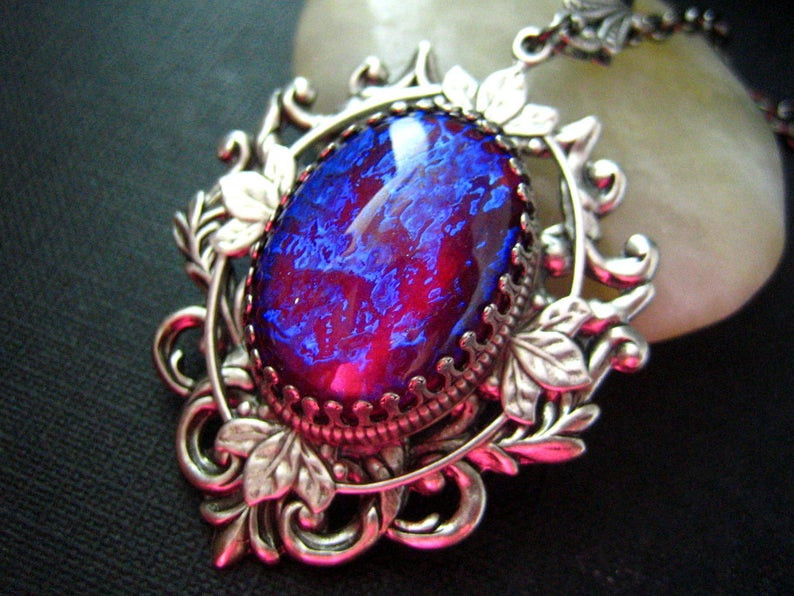 上の写真:ドラゴンズブレスオパール
上の写真:ドラゴンズブレスオパール
10. 天然 vs. 合成 vs. 模造
合成オパールは、天然素材と同じ物理的・化学的特性を持つように研究室で作られています。類似品または模造オパールは、ガラスや樹脂など、オパールとは無関係の素材ですが、外観はオパールに似ています。
天然オパールは、合成オパールや類似品よりも常に価値があります。合成オパールは一般的に数ドル程度ですが、それでも類似品よりも価値があります。
合成オパールは、実質的にあらゆる色があり、多くの場合、強烈な色彩変化を示します。合成オパールの種類には次のようなものがあります。
注: 「オパライト」は、樹枝状の含有物を持つ天然のグリーンオパールを指すこともあります。
 上の写真:スモーク加工されたエチオピア産ウェロオパール
上の写真:スモーク加工されたエチオピア産ウェロオパール
11. トリートメントとコンポジット
オパールはサファイアなどの他の宝石ほど頻繁に処理されることはありませんが、様々な処理方法があります。処理されたオパールは、処理されていないオパールよりも価値が低くなります。
オパール処理には次のものが含まれます。
砂糖と酸:最も一般的なオパール処理。 アンダムーカマトリックスオパールによく行われる。
スモーキング:ハイドロファン標本から「黒い」エチオピアオパールを作成する場合や、マトリックスオパールを暗くする場合によく使用されます。
染料:エチオピア産オパールの一部によく使用され、通常は「ブラック」オパールを作るのに用いられる。
樹脂処理:クイーンズランド産ボルダーオパールに時々行われ、オパール層を母岩にしっかりと結合させる。
亀裂充填/オイル塗布:ひび割れなどの傷のあるオパールの多くに一般的。オプティコンによるオイル塗布は、ハイドロファンオパールやひび割れオパールの安定化にやや一般的。
表面コーティング:耐久性を向上させるために、一部のクイーンズランド産ボルダーオパールに新しい化学蒸着(CVD)処理が施されています。
オパール処理の多くは、この品種の高い価値を考慮して、ダークベースのオパールを作るために行われます。エチオピア産ハイドロファンオパールは多孔質で吸収しやすいため、処理に人気の標本です。アンダムーカ産マトリックスオパールのほとんどは、糖酸処理が施されています。
販売者は常に処理方法を明らかにする必要がありますが、 一部のオパールの処理については自分でテストすることもできます。
オパールの加工方法には、天然オパールに合成素材を加えて複合オパールを作る方法もあります。複合オパールには、ダブレット、トリプレット、モザイク、チップオパールなどがあります。複合(または「組み立て」)されていない天然オパールは、ソリッドオパールと呼ばれます。
通常、ダブレットオパールの価格は、似たような外観のソリッドオパールの価格の15~35%程度ですが、最高品質のダブレットオパールは似たような外観のソリッドオパールの価格の50%に達することもあります。トリプレットオパールの価値は大幅に低く、似たような外観のソリッドオパールの価格の約1%程度です。
次に、上記のすべての要素がオパールのグレードにどのように影響するかを見てみましょう。

オパールのグレードは何ですか?
ダイヤモンドのような人気宝石の確立されたグレードとは異なり、オパールには公式のグレードはありません。しかし、様々な販売業者や業界リーダーが独自のオパールグレードを作成しています。
まず、国際宝石協会 (IGS) によるオパールのグレードカテゴリーを見てみましょう。
IGSオパールグレーディング
国際宝石協会では、オパールの専門家であるポール ダウニング博士によって作成されたオパールの等級を 5 つのカテゴリーに分類しています。以下に、価値の低いものから高いものの順に概説します。
これらのカテゴリーでは、色(本体の色調と遊色効果の両方)、遊色の方向性、カットの品質、欠陥(つまり、透明度と透明性)が考慮されます。
エクストラファインオパールのカラット当たりの価値は、商業的価値未満よりもかなり高くなります。
商業グレード未満:淡い色、低輝度。遊色効果はほとんどなく、方向性がある。カットが不均一、厚すぎる、または十分でない。目に見える内包物またはマトリックスがかなりある。
商業用:1色から2色、鈍い明るさ。遊色効果は非常に方向性がある。表面が不均一、厚すぎる、または薄すぎる。目に見える内包物がいくつかある。
良好:複数の色、良好な明るさ。遊色効果はやや方向性あり。カットは良好から優秀。目に見える内包物はわずか。
良好:複数の色、優れた明るさ、わずかに方向性があるか方向性がない遊色効果、良好から優れたカット、肉眼で見える内包物なし
エクストラファイン:あらゆる色彩、鮮やかな輝き、あらゆる方向から見える無方向性遊色効果、良好から優れたカット、10倍の拡大で内包物が見えない
オパールは複数のカテゴリーに当てはまるように見える場合があります。その場合、最も重要な要素はボディの色調と遊色効果です。オパールが2つのグレードに分かれている場合は、その中間のグレードを選択するのが適切かもしれません(例えば、CommercialとFineに分かれているオパールは、Goodを意味する場合があります)。
その他のオパールグレード
IGS鑑定システム以外では、他の販売者が独自のオパールグレードを使用する場合があります。一般的なグレードとしては、AAAAからA、またはHeirloomからGoodまでのグレードがあります。
ヘリテージ(AAAA) :上位1%;不透明、傷なし、鮮やかな遊色効果
最高(AAA) :上位10%;不透明、ごくわずかな傷あり;中程度の遊色効果
優良(AA) :上位33%;不透明、わずかな傷あり;遊色効果は少ない
良好(A) :上位75%;不透明、表面の傷、遊色なし
IGS グレードはより確立されているため、他のオパール グレードよりも IGS グレードに従うことをお勧めします。
オパールの等級分けの要素とカテゴリーがわかったところで、オパールの種類ごとに 1 カラットあたりのオパール価格を確認してみましょう。
オパールの種類と価値:それぞれの価格
ここまでで、オパールの価値を決める第一の要素はオパールの種類であることはお分かりいただけたと思います。オパールの種類は非常に多様で、産地や地色などの要素によって分類されます。
最も価値の高いオパールの色は何色かと疑問に思うかもしれません。それは、最も希少価値の高いブラックオパールです。一般的なオパールの中では、レッドオパールが最も希少です。
しかし、まずはもっと手頃な種類であるホワイトオパールの価格から始めましょう。
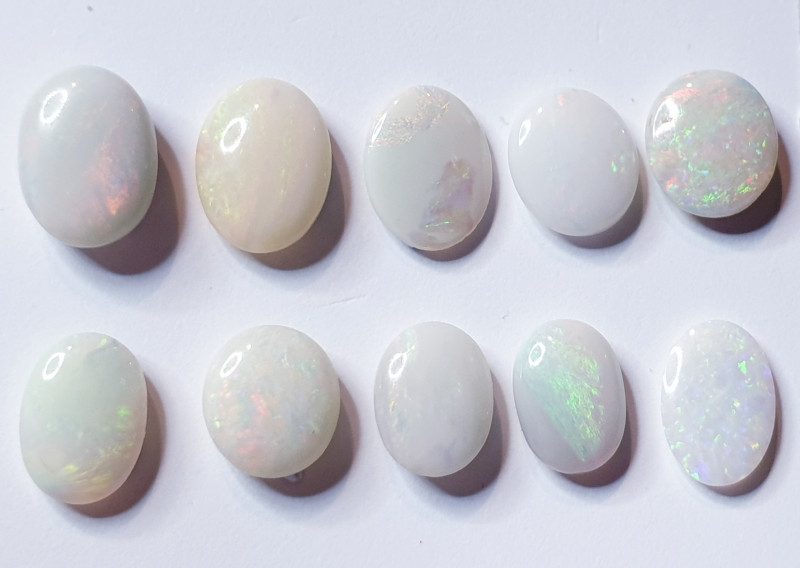
ホワイトオパール
ホワイトオパールまたはライトオパールは最も一般的なオパールの色で、より手頃な価格の選択肢となります。ただし、ホワイトオパールのカラットあたりの価格は大きく異なります。
低品質のホワイトオパールは1カラットあたり10ドル程度で取引されることもあります。これらは濁っていて不透明で、遊色効果がないことが多いです。一方、最高品質のホワイトオパールは1カラットあたり6,000ドルに達することもあります。
最高品質のホワイトオパールは、透明度に近く、目に見える内包物がなく、強烈で方向性のない輝きを伴う優れた遊色効果を示します。
それでも、ホワイトオパールの背景が明るいため、遊色効果はダークオパールほど明るく現れることはありません。
ホワイトオパールのカラットあたりの価格は、グレードとボディトーン(N7~N9)によって異なります。
N7オパール:1カラットあたり10ドルから2,400ドル(中間価格:1カラットあたり150ドルから500ドル)
N8オパール:1カラットあたり10ドルから2,200ドル(中間価格:1カラットあたり70ドルから250ドル)
N9オパール:1カラットあたり1ドルから2,000ドル(中間価格:1カラットあたり15ドルから90ドル)
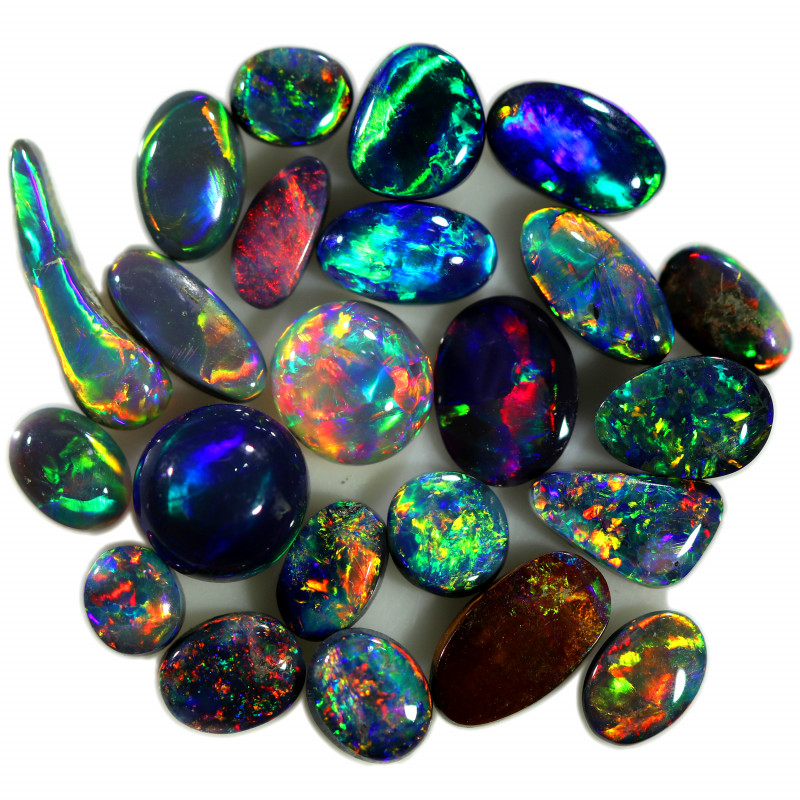
ダーク&ブラックオパール
ダークトーンのオパール、特にライトニングリッジ産のオパールは、オパールの中でも最も価値の高い品種の一つです。灰色、黒、時には濃い青の色をしているため、「ダークオパール」とも呼ばれています。その価値の一部は、暗い背景と鮮やかな遊色効果のコントラストにあります。
このカテゴリーの天然オパールを閲覧してみませんか?
ブラックオパールを購入する
この種類の価値は、ボディの色調よりも明るさの方が重要であり、不透明な石は透明なブラッククリスタルオパールよりも価値があります。
N1~N4の石の価格:
1~10カラット:1カラットあたり10~16,000ドル
10カラット以上:1カラットあたり10~20,000ドル
中品質の N1 から N4 の価格は、1 カラットあたり 300 ドルから 1,400 ドルの範囲です。
N5からN6の石(「ダークオパール」)の価値:
1~5カラット:1カラットあたり10~5,000ドル
5~10カラット:1カラットあたり10~7,000ドル
10カラット以上:1カラットあたり10ドル~6,400ドル
中品質のダークオパールは、カラット重量に関係なく、1カラットあたり300ドルから1,200ドルで取引されます。

カラーコモンオパール
遊色効果のない一般的なカラーオパールの価格は、主に希少性によって異なります。
赤、オレンジ、黄色はどうですか?それらはすべてファイアーオパールとしてカウントされます!
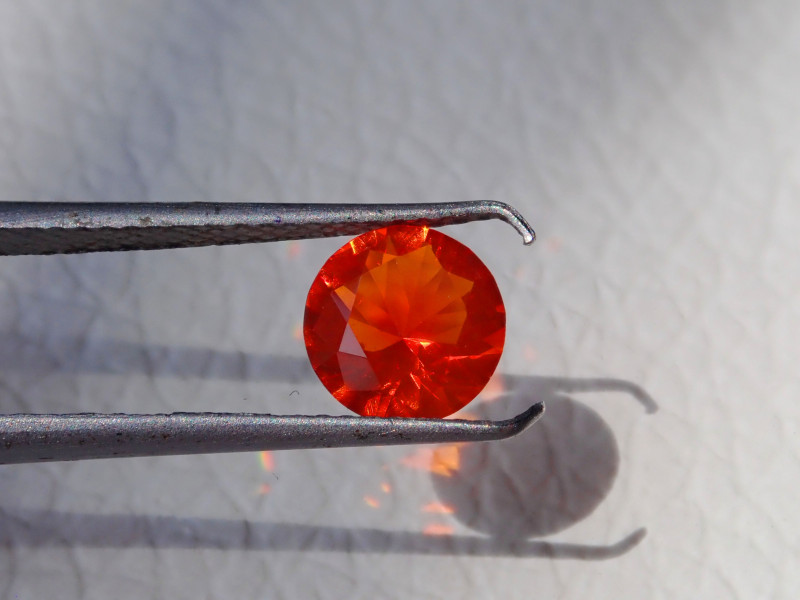
ファイアーオパール
赤、オレンジ、黄色、またはこれらの色の組み合わせのオパールはファイアーオパールと呼ばれます。ファイアーオパールには一般的なものと貴重なものがありますが、後者はより希少で高価です。最も価値の高いファイアーオパールは、透明で均一な色をしており、鮮やかな赤オレンジまたは赤色をしています。
最も有名なのはメキシコ産のファイアーオパールですが、オーストラリアとエチオピアでも産出されます。ファイアーオパールは、一般的に半透明から透明で、ファセットカットが施されているという特徴もあります。 メキシコ産はコモンファイアーオパールであるのに対し、エチオピア産はネオンバイオレットやグリーンの遊色効果を持つ、より価値の高いプレシャスファイアーオパールを産出します。
ファセットカットされたファイアーオパールの価格は1カラットあたり10ドルから250ドルです。カボションカットのファイアーオパールは1カラットあたり25ドルから300ドル、インマトリックスカットの場合は1カラットあたり25ドルから135ドルです。

透明オパール:クリスタル、ジェリー、コントラルズ、ハイアライト
オパールの透明度は稀ですが、無色透明で知られる種類もいくつかあります。レンタル:クリスタルオパール、ジェリーオパール、コントラルズ、ハイアライト。
クリスタルオパールは、濃い色調のオパールに次いで最も価値の高いオパールの一つとされています。この貴重なオパールは無色透明で、乳白色ではなく、ボディトーンスケールではN7からN8に相当します。
カラット重量範囲別のクリスタルオパールの価格は次のとおりです。
1~5カラット:1カラットあたり2~6,000ドル
5~10カラット:1カラットあたり2~6,400ドル
10カラット以上:1カラットあたり2ドルから6,000ドル
次はジェリーオパール、別名ウォーターオパールです。これは無色透明で、ゼラチンのような外観を持つ貴重なオパールです。クリスタルオパールよりも少し濃い色をしています。
ジェリーオパールの価値は通常、1カラットあたり5ドルから140ドルの範囲です。
コントラルズ オパールは、後ろから光を当てると内部に遊色が浮かんでいるように見える無色の貴重なオパールです。
コントラルズオパールの価格は1カラットあたり150ドルから200ドルの範囲です。
最後にご紹介するのは、無色、淡黄色または緑色で、強い緑色の蛍光を発する一般的なオパール、ハイアライトです。ハイアライトオパールの価格は、1カラットあたり6ドルから1,000ドル近くまでと幅広くなっています。
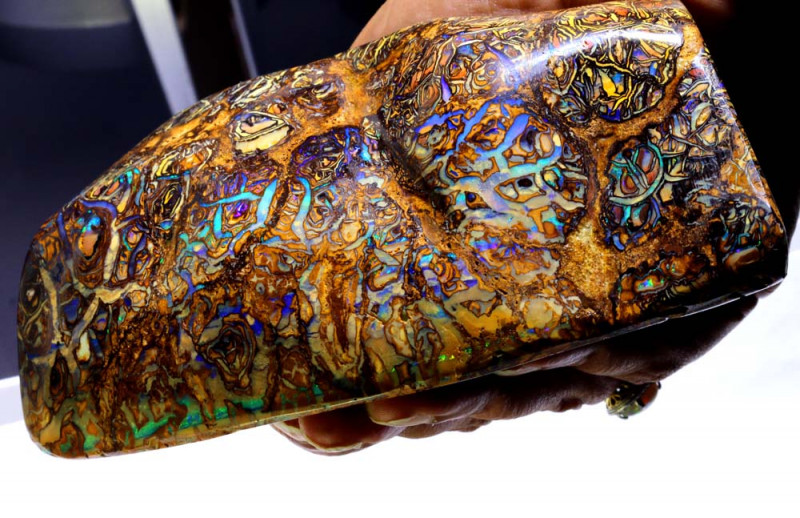
ボルダーオパールとマトリックスオパール
ボルダーオパールは、鉄鉱石または砂岩に、天然のプレシャスオパールが点在したり、薄い層状に付着したりしたオパールです。マトリックスオパールも同様ですが、プレシャスオパールが岩石の粒子間の隙間を埋め、より広範囲に遊色効果を生み出します。
ボルダーオパールとマトリックスオパールの価格は同じカテゴリーです。
1~5カラット:1カラットあたり10~1,000ドル(中間価格:1カラットあたり100~180ドル)
5~10カラット:1カラットあたり10~2,000ドル(中間価格:1カラットあたり90~200ドル)
10~15カラット:1カラットあたり10~5,000ドル(中間価格:1カラットあたり120~400ドル)
15カラット以上:1カラットあたり10~8,000ドル(中間価格:1カラットあたり200~600ドル)
ヨワナッツのような特定のサブタイプは、より高価になる場合があります。
コンポジットオパール:ダブレットとトリプレット
ダブレットやトリプレットは、ソリッドオパールの代わりとしてお手頃な価格でご提供しています。ほぼすべてのオパールをダブレットにすることができるため、価格は使用するオパールの種類によって異なります。

オパールオークションでは、ダブレットオパールは1カラットあたり0.90ドルから約230ドル、トリプレットオパールは1カラットあたり1ドルから約170ドルで販売しております。
合成オパール
もう一つの手頃な選択肢は合成オパールです。合成オパールにも人気のある種類がいくつかあります。
オーロラオパールは1カラットあたり1ドル以下が一般的です。合成オパライトは1個あたり1ドルから3ドルが一般的です。ドラゴンブレスオパールは1個あたり4ドルから75ドルまで、スターリングオパール(またはモナークオパール)は1個あたり4ドルから450ドルまでです。
 あなたにぴったりのオパールを見つける準備はできていますか?
あなたにぴったりのオパールを見つける準備はできていますか?
ご覧の通り、オパールの価値を評価するのは複雑ですが、それはオパールが非常にユニークで多様な宝石であるからです。オパールの価値と評価に何が含まれるかを知っておくことで、最高の取引ができるという確信を得られるでしょう。
購入の準備はできましたか?販売中の天然オパールをすべて閲覧するか、ブラックオパールを直接ご覧ください。
Opal Encyclopedia検索
最新記事
ブラックオパールは、オパールの中でも最も人気のある種類です。深いベースが表面に虹色の輝きを放ちます。ブラックオパールの用途、特性、歴史、そして価値についてご紹介します。
7th Dec 2025
フレイムクイーン(またはファイアクイーン)オパールは世界で最も高価なオパールで、現代の価値で300万ドル相当で取引されています。その歴史と品質について詳しく学びましょう!
18th Feb 2023
記事のカテゴリ
All there is to know about Opals including Black Opals, Ethiopian Opals & Boulder Opal
14記事数
Check out our fascinating information and articles on all things amazing in the Opal world
41記事数




